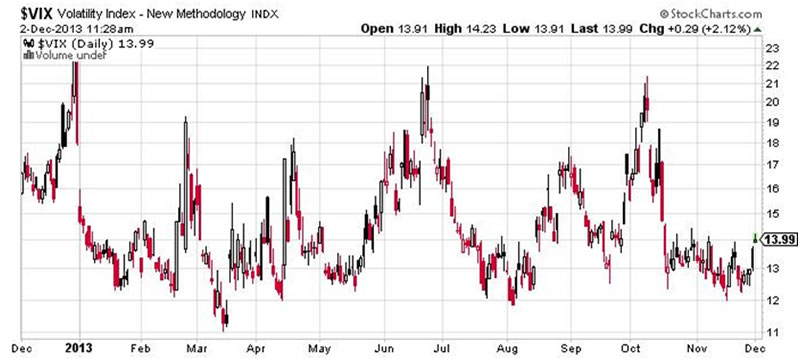Is U.S. Inflation Running at 7.7%?
Stock-Markets / Inflation Dec 05, 2013 - 10:17 AM GMT Michael Lombardi writes:
Can you believe this?
Michael Lombardi writes:
Can you believe this?
The Bureau of Labor Statistics (BLS) reports the U.S. economy experienced deflation in October. The Consumer Price Index (CPI), a widely followed government measure of inflation, declined 0.1% in October.
The Producer Price Index (PPI), which measures the change in prices that producers pay, also declined in October—by 0.2%, continuing its slide from September when it declined 0.1%. (Source: Bureau of Labor Statistics web site, last accessed December 2, 2013.)
But I don’t buy any of this. The government statistics are heavily skewed and do not present the real picture of what’s going on with inflation in the U.S. economy.
Just look at the annual PNC Wealth Management Christmas Prices Index. Every year, the firm tracks the prices of the items of the “12 Days of Christmas” through its Christmas Price Index. It looks at prices compared to last year.
Surprise! This year, the cost of all those items will be 7.7% higher than last year. With its finding, the Managing Executive of Investments for PNC Wealth Management, Jim Dunigan, said, “We were surprised to see such a large increase from a year ago, given the overall benign inflation rate in the U.S.” (Source: “Cost Of Items In ‘12 Days Of Christmas’ Tops $114,000,” The Associated Press, December 2, 2013.)
As I have been writing since the Fed started its second round of quantitative easing (QE2), inflation in the U.S. economy is going to be a huge problem going forward. There is no way the continued printing of $85.0 billion a month in new paper money won’t create inflation problems.
While my readers are likely tired of hearing it, I continue to favor gold-related investments as a hedge against coming inflation, especially with gold prices being so depressed. I believe investors will one day look back at 2013 and say, “I should have bought gold when it was trading at $1,200 an ounce.”
Michael’s Personal Notes:
In the first 11 months of this year, key stock indices like the S&P 500 have gone up 26%. But as this happened, we saw optimism towards stocks increase and fundamentals became weak—two major negatives for stocks going into 2014.
According to the Investment Company Institute (ICI), U.S. long-term stock mutual funds have been witnessing massive inflows. Between the week ended October 23, 2013 and the week ended November 20, 2013, U.S. long-term stock mutual funds saw inflows of $23.95 billion. (Source: Investment Company Institute, November 27, 2013.)
It seems investors are confident key stock indices will continue to go higher. Risk is not a concern anymore. One of the ways this can be seen is via the Chicago Board Options Exchange (CBOE) Market Volatility Index—better known as the “VIX.” This index gauges the amount of fear in the key stock indices. You will see in the chart below how the VIX is breaking down to new lows.

Chart courtesy of www.StockCharts.com
The VIX is saying investors are far from worried about a decline in key stock indices. But the optimism doesn’t end here; I’ve read several analysts say key stock indices will soar higher. One of the most recent examples is Adam Parker from Morgan Stanley (NYSE/MS). He believes that the S&P 500 (currently at 1,800) will reach 2,014 by the end of next year. (Source: Wall Street Journal, December 2, 2013.)
On the fundamental side, the most critical factor for a rally in key stock indices—corporate revenue and earnings growth—just isn’t there. Consider this: as of November 29, almost all of the companies in the S&P 500 have reported their corporate earnings for the third quarter of 2013. We found little more than half of the companies on the S&P 500 were able to beat revenues forecasted by analysts. (Source: FactSet, November 29, 2013.)
Does all this mean we have formed a top in key stock indices? Dear reader, we can say a market is overpriced and due for a correction. We can see the fundamentals behind the market just don’t make sense anymore. But we always have to remember that irrationality can go on for longer than most expect. But in all cases, regression to the mean does follow…and often when it’s least expected.
This article Inflation Running at 7.7%? is originally publish at Profitconfidential
Michael Lombardi, MBA for Profit Confidential
http://www.profitconfidential.com
We publish Profit Confidential daily for our Lombardi Financial customers because we believe many of those reporting today’s financial news simply don’t know what they are telling you! Reporters are trained to tell you the news—not what it can mean for you! What you read in the popular news services, be it the daily newspapers, on the internet or TV, is the news from a “reporter’s opinion.” And there’s the big difference.
With Profit Confidential you are receiving the news with the opinions, commentaries and interpretations of seasoned financial analysts and economists. We analyze the actions of the stock market, precious metals, interest rates, real estate and other investments so we can tell you what we believe today’s financial news will mean for you tomorrow!
© 2013 Copyright Profit Confidential - All Rights Reserved
Disclaimer: The above is a matter of opinion provided for general information purposes only and is not intended as investment advice. Information and analysis above are derived from sources and utilising methods believed to be reliable, but we cannot accept responsibility for any losses you may incur as a result of this analysis. Individuals should consult with their personal financial advisors.
© 2005-2022 http://www.MarketOracle.co.uk - The Market Oracle is a FREE Daily Financial Markets Analysis & Forecasting online publication.



